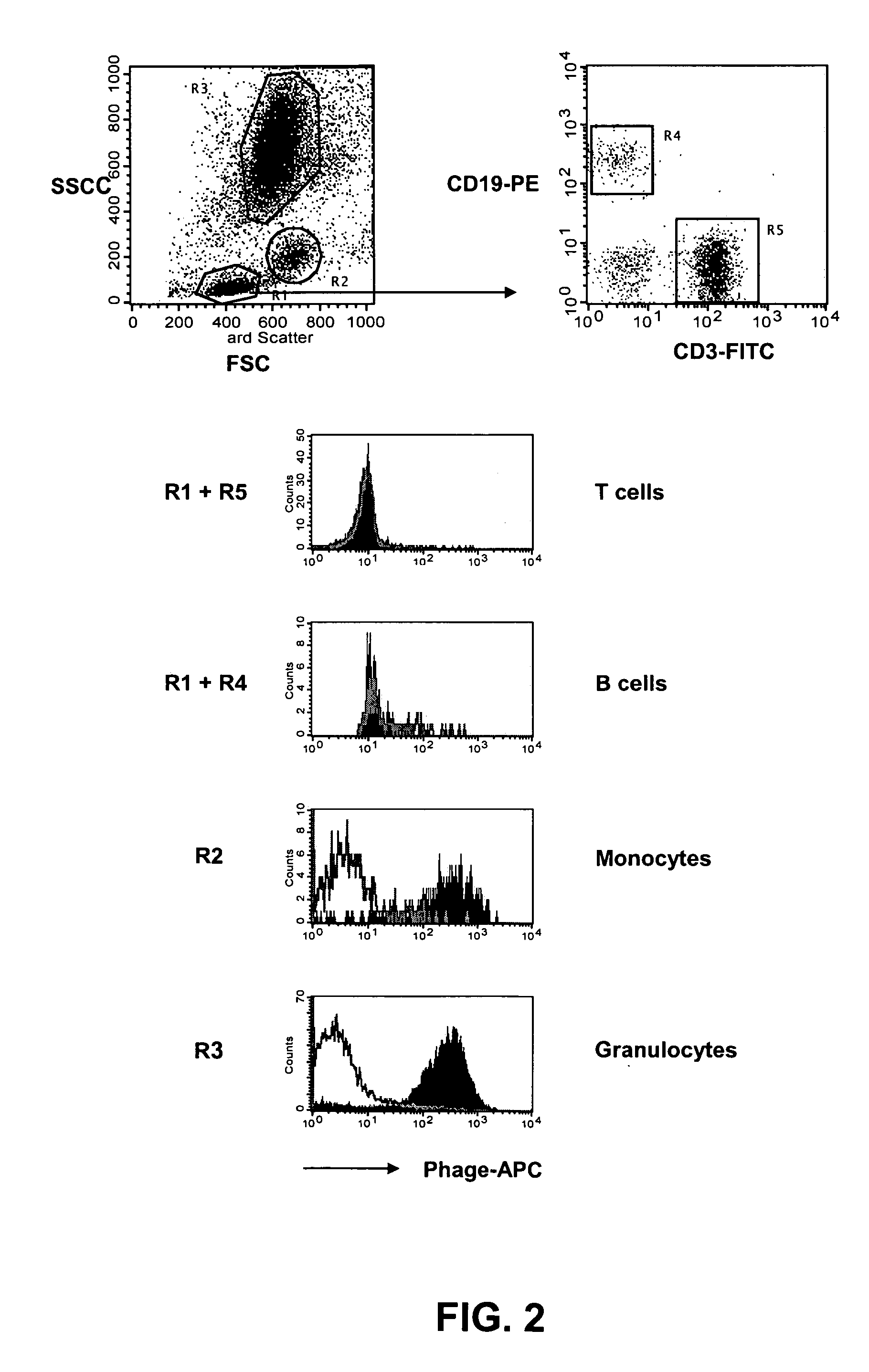Binding molecules for the treatment of myeloid cell malignancies
a myeloid cell and binding molecule technology, applied in the field of biotechnology, can solve the problems of inability to treat, elicit unwanted immune reactions, and contain humanized antibodies, and achieve the effect of preventing and being suitable for diagnosis
- Summary
- Abstract
- Description
- Claims
- Application Information
AI Technical Summary
Benefits of technology
Problems solved by technology
Method used
Image
Examples
example 1
Selection of Phages Carrying Single Chain Fv Fragments Specifically Recognizing Human Acute Myeloid Leukemia Cells
[0146] Antibody fragments were selected using antibody phage display libraries, general phage display technology and Mabstract® technology, essentially as described in U.S. Pat. No. 6,265,150 and in WO 98 / 15833 (both of which are incorporated by reference herein). Furthermore, the methods and helper phages as described in WO 02 / 103012 (incorporated by reference herein) were used in the present invention. For identifying phage antibodies recognizing AML tumor cells phage selection experiments were performed using the AML tumor cell line HL60 and primary AML tumor cells that were obtained from bone marrow aspirates of AML patients.
[0147] An aliquot of a phage library (500 μl, approximately 1013 cfu, amplified using CT helper phage (see WO 02 / 103012)) was blocked and presubtracted by mixing the library with 10 ml of RPMI 1640 medium with 10% FBS containing 230*106 periph...
example 2
Characterization of scFv SC02-357 and Related scFvs
[0148] Plasmid DNA was obtained from the selected scFv clone SC02-357 according to standard techniques known in the art. Thereafter, the nucleotide sequence of scFv clone SC02-357 was determined according to standard techniques well known to a person skilled in the art. Alignment analysis in a database of previously selected phage antibodies recognizing unknown targets revealed two other scFvs, called SC02-378 and SC02-161, sharing high homology in both heavy chain framework as well as CDR3 regions and sharing an identical light chain, indicating that these phage antibodies most likely recognized the same target antigen.
[0149] The nucleotide sequences of the scFvs called SC02-357, SC02-378 and SC02-161 are listed in Table 1 and have the SEQ ID NOS:14, 16 and 18, respectively. The amino acid translation of the nucleotide sequences of the scFvs SC02-357, SC02-378 and SC02-161 are also listed in Table 1 and have the SEQ ID NOS:15, 1...
example 3
Expression of the Antigen Recognized by SC02-357 on Primary AML Samples, Tumor Cell Lines and Normal Hematopoetic Cells
[0150] The distribution of the target antigen recognized by the SC02-357 phage antibody was analyzed by flow cytometry using primary AML samples, tumor cell lines and normal hematopoetic cells derived from bone marrow and peripheral blood. For flow cytometry analysis, phage antibodies were first blocked in an equal volume of PBS, 4% milk protein (MPBS) for 15 minutes at 4° C. prior to the staining of the various cells. The binding of the phage antibodies to the cells was visualized using a biotinylated anti-M13 antibody (Santa Cruz Biotechnology) followed by addition of streptavidin-allophycocyanin or streptavidin-phycoerythrin (Caltag).
[0151] Analysis of a set of four different primary AML blasts (FAB subtypes: AML7, FAB-M4; AML9, FAB-M1; AML10, FAB-M2; AML11, FAB-M0) showed strong binding of the SC02-357 phage antibody to all AML patient samples as compared to ...
PUM
| Property | Measurement | Unit |
|---|---|---|
| temperature | aaaaa | aaaaa |
| pH | aaaaa | aaaaa |
| concentration | aaaaa | aaaaa |
Abstract
Description
Claims
Application Information
 Login to View More
Login to View More - R&D
- Intellectual Property
- Life Sciences
- Materials
- Tech Scout
- Unparalleled Data Quality
- Higher Quality Content
- 60% Fewer Hallucinations
Browse by: Latest US Patents, China's latest patents, Technical Efficacy Thesaurus, Application Domain, Technology Topic, Popular Technical Reports.
© 2025 PatSnap. All rights reserved.Legal|Privacy policy|Modern Slavery Act Transparency Statement|Sitemap|About US| Contact US: help@patsnap.com



